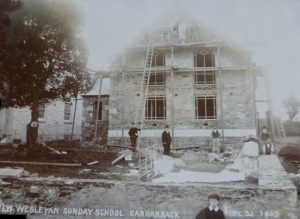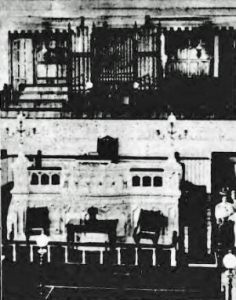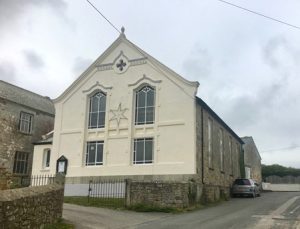
Carharrack is a village two miles east of Redruth in a former mining area. Its Wesleyan Chapel has stood on the same site since 1768. This profile has been compiled by Jo Lewis and Tony Mansell with information provided by Barrie May of Carharrack.
1768: Gwennap Octagon Wesleyan Chapel built, modelled on Wesley’s City Road Chapel.
1800: Chapel extended.
1814: Chapel demolished.
1815: New chapel built on same site. (West Briton and Cornwall Advertiser – Monday 02 September 1907)
“…It was enlarged in 1824, and a new front put in about thirty-six years later…” (West Briton and Cornwall Advertiser – Monday 02 September 1907)
Early C19: Wesleyan manse, now a private house. Stucco with stucco detail including window architraves and wooden pilastered doorcase with moulded hood on consoles. 2 storeys; symmetrical 3-window front. Appearance of this rare manse now marred by inappropriate uPVC windows. Part of a very interesting group. (Cornwall Council Heritage Gateway)
The Church was clearly highly regarded for its spaciousness and in 1828 the chapel was being offered as an alternative venue for speeches at Gwennap Pit when the weather was foul (Western Times).
1841: 250 attended morning service and 800 attended evening service.
1857: Schoolroom added.
1863: The church was registered for marriages (Western Daily Mercury)
1870: The church was led by Reverend J. B. West and several other Reverends had preached at the church, including from local chapels such as the Bible Christian in Redruth and others who had travelled from as far as Yorkshire. (Royal Cornwall Gazette 1870).
“A Scene in Carharrack Wesleyan Chapel. – An extraordinary, and to all lovers of Methodism, a very painful scene occurred in the Wesleyan Chapel here last Sunday evening. The choir, who have been much eulogised for their admirable singing of a selection from the good old Wesleyan tunes, according to their usual custom, sang a short piece after the first prayer, at the close of which the clergyman rose, and evidently in anger, demanded of the choir who had authorised them to sing a piece without consulting him. He then proceeded, in forcible language, to lecture the choir –many of them elderly men of respectability and position, as if they were children, and continued the harangue till he drove the whole: of the choir and many of the congregation from the chapel…” (Royal Cornwall Gazette – Saturday 12 October 1872)
1872: “The Scene at Carharrack Wesleyan Chapel. To the Editor of the Royal Cornwall Gazette. Sir, whilst looking over your valuable paper last week, one of the first and most alarming subjects that arrested my attention was that of the ‘painful scene’ at Carharrack Wesleyan chapel. It is no wonder that the writer called it a painful scene. If the choir had sung a piece which did not accord with the feelings or wishes of the minister, it would, according to my idea, have been his duty to have reproved them in a right spirit on some future day, and not to expose them before a public congregation. We are told in the
scriptures that ministers should warn affectionately that they should be examples to their-flocks, seek their salvation, pray for their people, preach with good will and love, and avoid giving unnecessary offence. This is not only my idea of the duties of a Christian minister, but St. Paul’s. Yours truly, UNITY. Carnmarth, October 14th, 1872.” (Royal Cornwall Gazette – Saturday 19 October 1872)
1882: “Carharrack. Re-opening of the Wesleyan Chapel. Services in connection with the re-opening of the Carharrack Wesleyan Chapel, which has undergone extensive alterations and a thorough renovation at a cost of nearly £220, were held on Sunday the 10th inst., …” (Royal Cornwall Gazette – Friday 22 December 1882)
1889: The church was described as “one of the finest Wesleyan Methodist chapels in the county – a relic of the John Wesley style of architecture”. (Cornish Telegraph in December 1889)
1889: New organ installed, made by Hele and Co of Plymouth. “The organ has cost £245 instead of £200, and it is undoubtedly one of the best made instruments turned out by the enterprising builders”. (Cornish Telegraph in December 1889)
1903: “Carharrack Wesleyan Methodists have decided to erect new Sunday school building.” (Royal Cornwall Gazette – Thursday 19 March 1903)
1906 – February: Adjoining schoolroom added. (West Briton and Cornwall Advertiser – Monday 02 September 1907)
 (https://s3.amazonaws.com/gs-geo-images/47e9f0e1-d727-460e-99b8-ab7e1bf1d104_l.jpg)
(https://s3.amazonaws.com/gs-geo-images/47e9f0e1-d727-460e-99b8-ab7e1bf1d104_l.jpg)
1906: Carharrack Wesleyan Sunday school opening. (Royal Cornwall Gazette – Thursday 15 February 1906)
1907: “Carharrack Wesleyan Church. Re-opening Services. The Wesleyan Methodist Church, Carharrack was re-opened on Thursday, after renovation and alterations of an extensive character. The church is 92 years old, having been erects in 1815. It was enlarged in 1824, and a new front put in about thirty-six years later. The schoolroom adjoining was added last February. In its present renovated form the church is one of the prettiest village Wesleyan churches in West Cornwall. The old plain ceiling has been taken down, and one of stamped steel substituted, and fixed at the level of the top of the original tie beams, thus giving an increased height to the building. The beams are cased and moulded, and the whole ceiling is vastly improved both in appearance and utility. The ground floor of the building has been entirely re-seated, and the seats in the spacious gallery much improved. Screens of pitch-pine have been erected behind the choir and at the ground floor and gallery entrances. The main doors have been made to open outwards, and the floor of the lobby has been laid with encaustic tiles. New oval topped windows have been put in. The two front windows are handsome specimens of stained-glass work, and were presented to the trustees, one in memory of the late Thomas Edward Morcom and the other in memory of the late William Halse. As viewed from the interior these glasses have most beautiful effect. The scheme of decoration is carried out in tones of light green on white, picked out in pink and gold, the whole producing a most pleasing effect. The carpets and upholstery is in rich dark crimson. The contract has been carried out by Mr. W. H. Moyle. Chacewater, and the decoration Mr. John Thomas, Redruth. Mr. Sampson Hill, Redruth, was the architect. The organ has been renovated and repaired Messrs. T. W. Spraggs and Sons, Redruth. A great deal of interest was taken in Thursday’s proceedings, and the occasion being favoured with fine weather, there was a large gathering to witness the unlocking of the doors. Mrs. E. M. Knuckey, of Lanner, had kindly consented to unlock the door. On her arrival she was met the Rev. Alfred S. Williams, Mr. W. J. Trebilcock. and Mr. Sampson Hill. Mrs. Knuckey was introduced by Mrs. Trebilcock, J and Mr. Sampson Hill then presented her with handsome key, mounted in silver, and which bore the inscription: “Presented to Mrs. E. M. Knuckey in commemoration of the reopening of Carharrack Wesleyan Methodist Church. August 29th, 1907.” Mrs. Knuckey returned thanks and referred to her memories of Carharrack. near which place she. was born. Tn conclusion she unlocked and opened the doors… About eighteen months ago they built the schoolroom, and there was now debt only of £150 on the building…” (West Briton and Cornwall Advertiser – Monday 02 September 1907)
1907: Re-opened following renovation. (Cornubian and Redruth Times – Thursday 05 September 1907)
1857-1907: Minutes, Trust, Carharrack Wesleyan Chapel, Gwennap. (Kresen Kernow MRR/9042)
 Interior of Carharrack Wesleyan Chapel (Cornubian and Redruth Times – Thursday 05 September 1907)
Interior of Carharrack Wesleyan Chapel (Cornubian and Redruth Times – Thursday 05 September 1907)
1920: “The Sunday school tea treat took place on Thursday afternoon in a field adjoining the chapel. Headed by the Carharrack Brass Band, the scholars paraded the town to St Day, and then returned to the field … A public tea was also provided.” (24 June 1920 – West Briton and Cornwall Advertiser)
1907-1924: Minutes, Trust, Carharrack Wesleyan Chapel, Gwennap. (Kresen Kernow MRR/9043)
1910-1925: Correspondence concerning trust, Carharrack Wesleyan Chapel, Gwennap. (Kresen Kernow MRR/1314)
1929: “Carharrack Wesleyan Church Re-Opening. Carharrack Wesleyan Church, which has just undergone renovations, was re-opened on Thursday evening…” (Cornishman – Thursday 26 September 1929)
1932: The Wesleyan, Primitive Methodist and the United Methodist Church amalgamated to become the Methodist Church of Great Britain.
1932: Became known as Carharrack Methodist Chapel.
The chapel was part of Gwennap Wesleyan Circuit until 1934, then Redruth Methodist Circuit. (SWChurches)
1946: “Carharrack Tea Treat. Assembling at the schoolroom, a procession was formed and, led by officers of the Sunday-school and Carharrack and St Day Silver Band, paraded the village and Trevarth, returning to the playing field where the children were served with tea and large saffron buns …” (27 June 1946 – Cornishman)
1950: Carharrack Wesley Sunday School: “The Rev. A. M. Freeman gave a short address and a procession led by officers of the Sunday school and Carharrack and St Day Silver Band paraded the village. The children were served with tea and saffron buns …” (29 June 1950 – Cornishman)
1975: Became known as Carharrack Methodist Church following the closure of Billy Bray Memorial Methodist Church. (SWChurches)
Circa 2004: Closed.
2017: Chapel sold but schoolrooms retained.
2021: Schoolrooms in use as chapel and schoolroom.
Carharrack Methodist church is part of the Falmouth and Gwennap Circuit.
A ” Museum to Cornish Methodism” is situated in the listed Wesleyan Chapel, built on a plot of land between Wheal Damsel Road and Chapel Terrace in 1812. This replaced the older Octagon Chapel at Gwennap where Wesley had often preached between 1743 -1762. The building is in a fine setting with the Sunday schoolroom built in 1906 on the same site. The old village pump is also preserved here, re-erected by the Old Cornwall Society in 1990. The museum is open in summer, by appointment only: for info. Tel. 01209 820381. (http://gwennap-opc.vingoe.name/The%20Old%20Parish.htm)
 Carharrack Methodist Church (Photo: Jo Lewis)
Carharrack Methodist Church (Photo: Jo Lewis)
 Carharrack Methodist Sunday School (Photo: Jo Lewis)
Carharrack Methodist Sunday School (Photo: Jo Lewis)
Various documents held at Kresen Kernow: https://kresenkernow.org/SOAP/search/Carharrack%20Wesleyan/
Large Wesleyan chapel plus attached mid C19 Sunday school and attached to this a late C19 Sunday school. Replaced 1768 octagonal chapel. Stuccoed front to original chapel and the later Sunday school, otherwise local rubble with granite dressings; dry slate and scantle slate roofs with crested clay ridge tiles. Classical style. Chapel has 2-storey, 2-window pedimented font with panelled end pilasters. Moulded hoods on brackets to windows with round-arched lights and coloured glass. Central doorway has Tuscan doorcase and traceried fanlight. Late C19 3-light windows to side elevations have traceried heads. Rear of chapel has apse with quadrant corners and original tall round-arched windows with intersecting glazing bars to their heads. Earlier schoolroom has original 16-pane sash windows. Later 2-storey schoolroom has 2-window show front with moulded gable with quatrefoil panel. Windows have shaped heads with moulded hoods over rusticated jambs; margin-glazed windows with some coloured glass. Memorial foundation stones. Interior of chapel is unique survival of this date with its original ceiling level and original horse-shoe gallery containing its original box pews with H-hinges. Good later C19 rostrum. Later Sunday school has gallery at the front end. Interior and apse illustrated in Stell (b1). (Cornwall Council Heritage Gateway)
01.08.2013 The Methodist Church notified the authority of the sale of the chapel which is now no longer covered by ecclesiastical exemption.
Carharrack Wesleyan Methodist Chapel is a Grade II listed building.
Cornwall Archaeological Unit report: https://docs.planning.org.uk/20210106/5/QL4OFOFGKZH00/lpig9tb6sszc5vl0.pdf
Listed Building Report: https://britishlistedbuildings.co.uk/101160248-carharrack-methodist-church-carharrack#.YEfnIZP7RfU
Wesleyan Methodist Chapel, now Methodist Church. Dated 1815 in gable; altered in later C19 and early C20. Uncoursed killas rubble with granite dressings, the front rendered and the sides and rear cement washed. Rectangular plan with shallow apse to rear. Two storeys, 2×5 bays; the symmetrical pedimented facade has a plinth, cornice, and large raised corner pilasters with sunk round-headed panels and coped upstands above the cornice; a wide central doorway with Tuscan pilasters, plain frieze and cornice; 2 windows at 1st floor with raised sills and floating cornices on fluted consoles, formerly sashed but now of 2 round- headed lights with stained glass; and a plain roundel in the pediment containing the raised date “1815”. Both side walls have square-headed windows like those at the front (added wing attached to 5th bay of right-hand side, not of special interest). The apse at the rear has rounded corners and 2 tall round-headed windows with intersecting glazing bars. Interior: horse-shoe gallery with panelled front, supported on wooden Tuscan columns, and completely furnished with 3 tiers of original box pews which have ramped sides and doors with H-hinges, and 6 turned lamp-standards with oil-lamps; former “City Road” arrangement of communion rail behind pulpit reversed, but fragments of the original remain behind the inserted rostrum, and the windows of the apse have cornices with fluted consoles (now concealed from the body of the church by the organ). History: replaced octagon chapel built in 1770; modelled on Wesley’s City Road chapel, like Camborne Centenary Chapel, Wesley Street, Camborne (q.v.). Reference: J.C.C.Probert The Architecture of Cornish Methodism (1966); Thomas Shaw A History of Cornish Methodism (1967).
